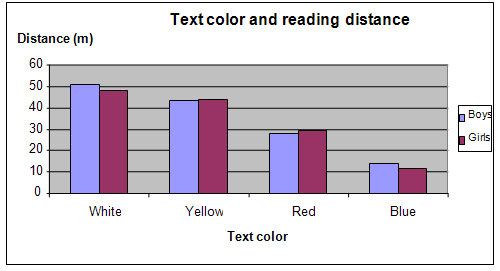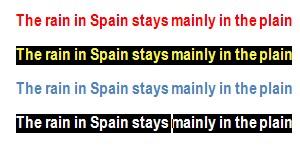| Complexity level: | 6 |
| Project cost ($): | 20 |
| Time required: | 2 days to prepare, 1 day for the science project experiment |
| Material availability: | May be purchased at a hardware store/supermarket |
| Safety concerns: | Handle the paper cutter and spray paint with care, using safety goggles and gloves. Adult supervision is required. |
Hypothesis
Participants will be able to view signboards with white or yellow text and a dark green background from a further distance, as compared to red or blue text.
Overview
Traffic signs
Traffic signs are normally placed along road sides and over roads in order to provide information to drivers. The information provided consist of safety warnings, speed limits or road directions. Sometimes pictorial signs are used instead of words in order to internationalize the road signs and to minimize the language barrier.
A driver will normally have only a few seconds to glance at a road sign and understand its contents. The size of the wording, the color of the background and the color of the lettering are very important for enabling the driver to read the message at a glance.
The optimal viewing distance of the road sign is also affected by lighting conditions and the font type used. Longer and more complicated messages are better separated into a few signboards and strategically placed at a distance along the road. This will help to minimize the length of time the driver is distracted when looking at the signs.
Scientific Terms
Materials
The materials required for this science fair project experiment:
- 4 metal sheets (1 meter x 1.5 meter)
- 4 cans of green spray paint
- 1 can each of white, yellow, red and blue color spray paint.
- Several large sheets of thin cardboard. Ensure that the sheets of cardboard are slightly larger than the metal sheets
- 10 male students aged 12 years old
- 10 female students aged 12 years old
- 1 ruler
- 1 paper cutter
- A football field
- A measuring tape
- An assistant to help coordinate the tests
Procedure
1. For this science fair project, the independent variable is the color of the text used on the green color sign board. The dependent variable is the average distance at which the participants were able to read the signs. This is determined by measuring the distance with a tape. The constants (control variables) are the size of the text and the amount of lighting on the day of the test.
2. The 4 metal sheets are spray painted with green paint and allowed to dry. Cut out the alphabets in the sheets of cardboard - the cardboard will serve as alphabet stencils that will be used to spray paint the words.
3. After the green background paint has dried, the alphabet stencils are used to randomly form 10 words which will be spray painted on each of the sign boards. The letters on the first board will be painted white, the second board yellow, the third board red and the fourth board blue. Different words are used on each signboard.
4. On the day of the test, all 20 students are led to the football field. They are made to stand 100 meters away from the 4 signboards. The participants are then brought closer to the signboards, a meter at a time, until they are able to read all 10 words. The distance from the sign board to the participant is then measured with the tape.
5. The distance for each sign board and gender is totaled and divided by 10 to obtain the average distance and recorded in the table given below.

Results
The results showed that the students were able to read the white and yellow-colored words from a farther distance compared to the red and blue words.
|
Text color, green background and average reading distance (meters) |
||||
|
White |
Yellow |
Red |
Blue |
|
|
Boys |
51 |
43 |
28 |
14 |
|
Girls |
48 |
44 |
29 |
12 |
The chart below represents the results of our science project experiment.

Conclusion
The hypothesis has been proven correct as the participants were able to view the signboards with white or yellow text and a dark green background from a further distance, as compared to red or blue text.
Road signs with contrasting signboard colors are very important in order to enable drivers to easily read the signs at a glance and to drive safely. If the size of the words is too small or the color contrast is poor, the driver may have to strain to look at the road sign for a longer period of time. This will compromise the safety of the driver and others on the road.
Also consider
To improve the reliability and accuracy of our results, a larger sample of colors should be used.
This science fair project may be repeated, this time, with participants of different age groups.
Modify the science project experiment, using different color combinations.
References
Traffic sign - http://en.wikipedia.org/wiki/Traffic_sign
Safety sign message viewing distance - http://www.safetysign.us/my_weblog/2009/04/safety-sign-message-viewing-distance.html

